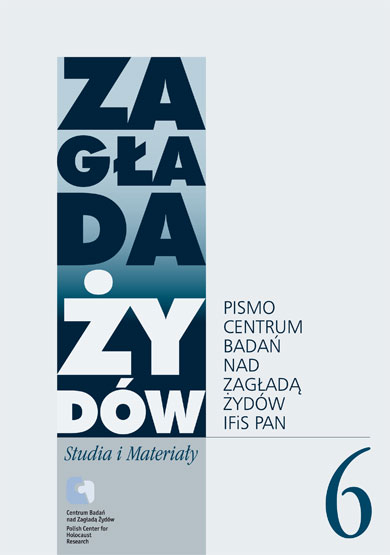Lagry w perspektywie genderowej
Zagłada Żydów. Studia i Materiały, Nr 6 (2010), Strony: 193-204
Data zgłoszenia: 2020-12-06Data publikacji: 2010-12-30
 https://doi.org/10.32927/zzsim.716
https://doi.org/10.32927/zzsim.716
Abstrakt
The questions of corporality, sexuality, women’s experience and their record examined in the context of camp issues and the Holocaust have only recently become the subject of attention. Gender studies play a significant role in the discussion on those issues. Existing works on the subject (i.a. the book of Bożena Karwowska Ciało. Seksualność. Obozy zagłady [Gender, Sexuality, Concentration Camps]) show that the tools of gender studies are cognitively useful, but, as it appears, their role of being particularly predestined to uncover what is marginalized or condemned to silence is overestimated. Nevertheless, apart from the dominance of the patriarchal discourse, there have always existed other reasons for suppressing the matter of corporality and sexuality both in works on KL’s and in science; social taboo (controlled not only by the male symbolical order) as well as the policy (e.g. it was possible to
write openly about rape on former female prisoners by Soviet soldiers only after censorship had been lifted) play an important role here. The fundamental value of the gender perspective lies in the firm approach towards the issues hitherto marginalized in the KL context – both by science and, to a lesser extent, literature (which is reflected by i.a. works of Pankowski and Posmysz published years ago).
Licencja
Prawa autorskie (c) 2010 Autor&"Zagłada Żydów. Studia i Materiały"

Utwór dostępny jest na licencji Creative Commons Uznanie autorstwa 4.0 Międzynarodowe.
https://creativecommons.org/licenses/by/4.0
Czasopismo publikowane jest w standardzie Diamond Open Access na licencji CC-BY-4.0 Deed - Uznanie autorstwa 4.0 Międzynarodowa - Creative Commons
Podobne artykuły
- Paweł Smoleński, Czy autor powinien być katonem? [Michał Wójcik, Zemsta] , Zagłada Żydów. Studia i Materiały: Nr 17 (2021)
- Aleksandra Ubertowska, Nowe geografie, podmioty i media w studiach nad Zagładą. A Companion to the Holocaust , Zagłada Żydów. Studia i Materiały: Nr 17 (2021)
- Bartłomiej Krupa, Tomasz Żukowski, Pod presją. Co mówią o Zagładzie ci, którym odbieramy głos [Bartłomiej Krupa] , Zagłada Żydów. Studia i Materiały: Nr 17 (2021)
- Daniel Logemman, Franziska Bruder, Das eigene Schicksal selbst bestimmen. Fluchten von Juden aus den Deportationszügen in die Vernichtungslager der „Aktion Reinhardt” in Polen [Daniel Logemann] , Zagłada Żydów. Studia i Materiały: Nr 17 (2021)
- Piotr Filipkowski, Piotr M.A. Cywiński, Auschwitz. Monografia Człowieka [Piotr Filipkowski] , Zagłada Żydów. Studia i Materiały: Nr 17 (2021)
- Katarzyna Tałuć, Krzysztof Rybak, Obrazowanie Zagłady. Narracje holokaustowe w polskiej literaturze XXI wieku dla dzieci i młodzieży , Zagłada Żydów. Studia i Materiały: Nr 20 (2024)
- Jerzy Kochanowski, Cisi bohaterowie („Stille Helden”) , Zagłada Żydów. Studia i Materiały: Nr 9 (2013)
- Jan Grabowski, Doris Tausendfreund, Erzwungener Verrat. Jüdische “Greifer” im Dienst der Gestapo, 1943-1945 , Zagłada Żydów. Studia i Materiały: Nr 4 (2008)
- Jacek Leociak, Miriam Akawia, Haderech ha’acheret , Zagłada Żydów. Studia i Materiały: Nr 3 (2007)
- Michel Laffite, Jonathan Littell, Les Bienveillantes , Zagłada Żydów. Studia i Materiały: Nr 3 (2007)
<< < 1 2 3 4 5 6 7 8 9 10 11 12 13 14 15 16 17 18 19 20 21 22 23 24 25 > >>
Możesz również Rozpocznij zaawansowane wyszukiwanie podobieństw dla tego artykułu.
 English
English
 Język Polski
Język Polski




